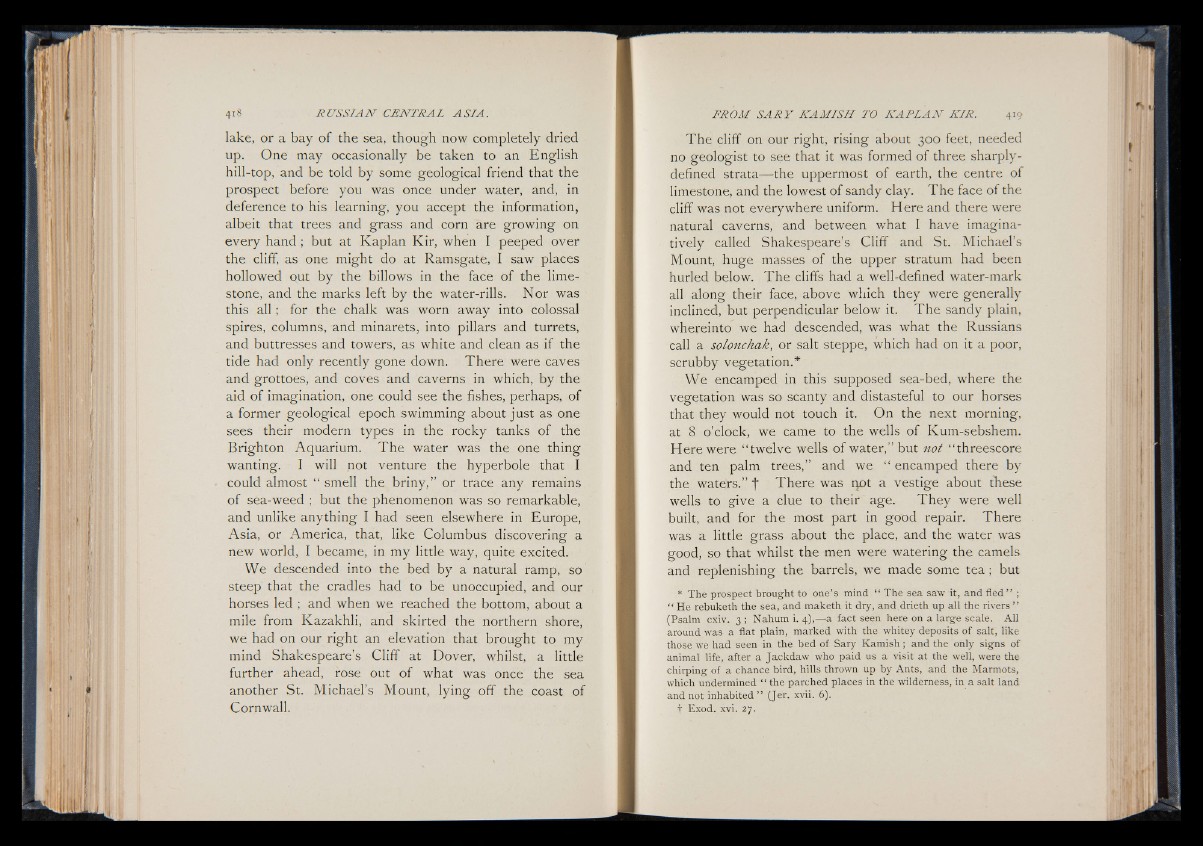
lake, or a bay of the sea, though now completely dried
up. One may occasionally be taken to an English
hill-top, and be told by some geological friend that the
prospect before you was once under water, and, in
deference to his learning, you accept the information,
albeit that trees and grass and corn are growing on
every hand ; but at Kaplan Kir, when I peeped over
the cliff, as one might do at Ramsgate, I saw places
hollowed put by the billows in the face of the limestone,
and the marks left by the water-rills. Nor was
this a l l ; for the chalk was worn away into colossal
spires, columns, and minarets, into pillars and turrets,
and buttresses and towers, as white and clean as if the
tide had only recently gone down. There were caves
and grottoes, and coves and caverns in which, by the
aid of imagination, one could see the fishes, perhaps, of
a former geological epoch swimming about just as one
sees their modern types in the rocky tanks of the
Brighton Aquarium. The water was the one thing
wanting. I will not venture the hyperbole that I
could almost “ smell the briny,” or trace any remains
of sea-weed ; but the phenomenon was so remarkable,
and unlike anything I had seen elsewhere in Europe,
Asia, or America, that, like Columbus discovering a
new world, I became, in my little way, quite excited.
We descended into the bed by a natural ramp, so
steep that the cradles had to be unoccupied, and our
horses led ; and when we reached the bottom, about a
mile from Kazakhli, and skirted the northern shore,
we had on our right an elevation that brought to my
mind Shakespeare’s Cliff at Dover, whilst, a little
further ahead, rose out of what was once the sea
another St. Michael’s Mount, lying off the coast of
Cornwall.
The cliff on our right, rising about 300 feet, needed
no geologist to see that it was formed of three sharply-
defined strata-B-the uppermost of earth, the centre o f
limestone, and the lowest of sandy clay. The face of the
cliff was not everywhere uniform. Here and there were
natural caverns, and between what I have imaginatively
called Shakespeare’s Cliff and St. Michael’s
Mount, huge masses of the upper stratum had been
hurled below. The cliffs had a well-defined water-mark
all along their face, above which they were generally
inclined, but perpendicular below it. The sandy plain,
whereinto we had descended, was what the Russians
call a solonchak, or salt steppe, which had on it a poor,
scrubby vegetation.*
We encamped in this supposed sea-bed, where the
vegetation was so scanty and distasteful to our horses
that they would not touch it. On the next morning,
at 8 o’clock, we came to the wells of Kum-sebshem.
H ere were “ twelve wells of water,” but not “ threescore
and ten palm trees,” and we “ encamped there by
the waters.” f There was not a vestige about these
wells to give a clue to their age. They were well
built, and for the most part in good repair. There
was a little grass about the place, and the water was
good, so that whilst the men were watering the camels
and replenishing the barrels, we made some tea ; but
* The prospect brought to one’s mind “ The sea sa'w it, and fled” ;
“ He rebuketh the sea, and maketh it dry, and drieth up all the rivers ”
(Psalm cxiv. 3 ; Nahum i. 4),— a fact seen here on a large scale. All
around was a flat plain, marked with the whitey deposits of salt, like
those we had seen in the bed of Sary Kamish; and the only signs of
animal life, after a Jackdaw who paid us a visit at the well, were the
chirping of a chance bird, hills thrown up by Ants, and the Marmots,
which undermined “ the parched places in the wilderness, in a salt land
and not inhabited ” (Jer. xvii. 6).
t Exod. xvi. 27.